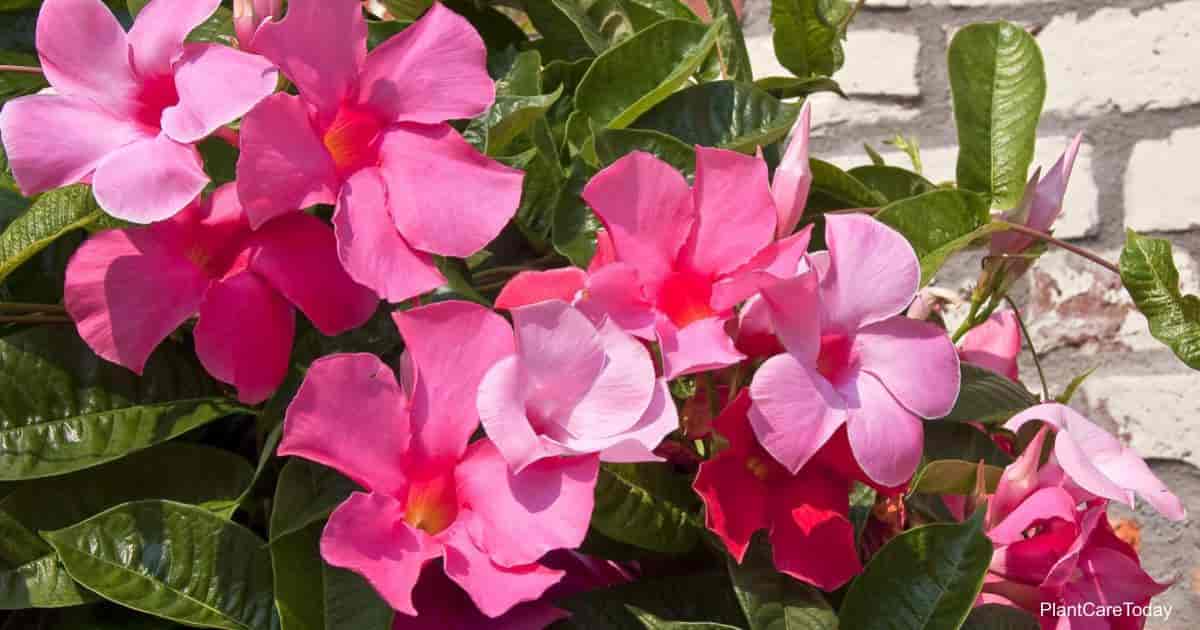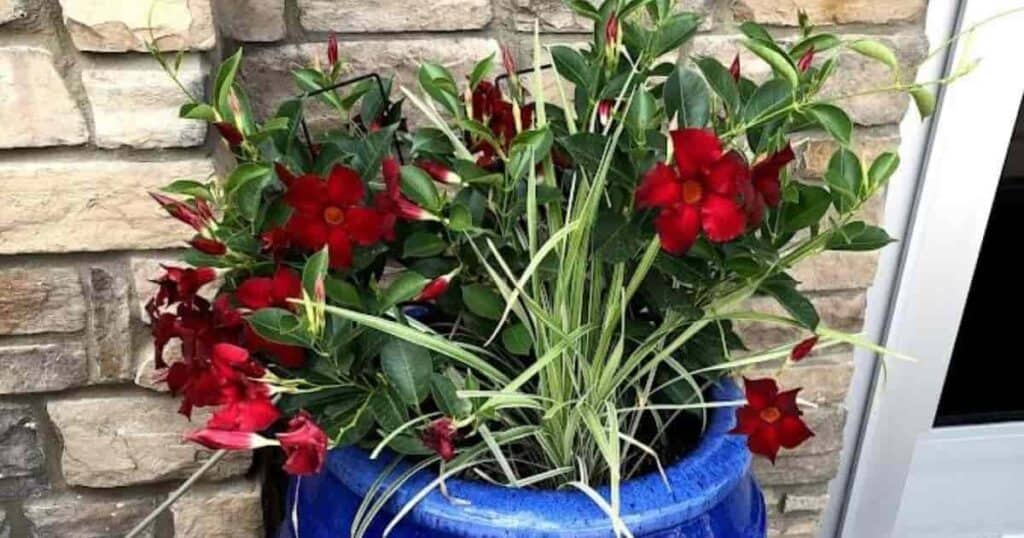One of the popular members of the dogbane family, Apocynaceae, is the Mandevilla plant (Mandevilla spp.), a tropical perennial with exotic and colorful flowers.
With over 100 species, this gorgeous climbing vine is grown to add a dramatic effect to the summer gardens and well-lit landscapes.

Mandevillas get their common name, Rock Trumpet or Trumpet Vine, due to their showy, bold, and fragrant blossoms resembling a trumpet.
This creeper flowering plant takes one growing season to climb the walls up to 10’ feet high and produces attractive flowers in various hues of white, yellow, orange, pink, red, and purple.
Another Apocynaceae considered toxic: Is the Desert Rose Poisonous?
These decorative plants seem as attractive to insects, bees, and animals as they do to garden owners.
Being native to warm climatic regions of Mexico, Central and South America, the West Indies, and South Western states of the U.S., Mandevilla plants grow year-round and survive winters fairly well even when grown in U.S. Department of Agriculture (USDA) hardiness zones 9 to 11.

Related: Learn winter care tips for Mandevilla
They prefer to remain indoors during the winter months.
Rock Trumpets love growing in bright, sun-lit areas in nutrient-rich, well-drained soil.
While being an easy care vine, they require some regular maintenance to keep them free from pests and diseases.
Mandevilla vines are displayed as a centerpiece in a spring garden, or they are blessed in the garden as a decorative patio plant or trellis vines with attractive blooms.
Is The Mandevilla Vine Poisonous Or Toxic?
As per the American Society for the Prevention of Cruelty to Animals (ASPCA), Mandevilla Plants are not included in the list of highly toxic poisonous plants for cats category.
However, Mandevilla belongs to the dogbane family consisting of some poisonous members like Oleander in USDA zones 8-10 and Periwinkle in USDA zones 4 to 9.

Mandevillas are not edible plants; hence when ingested, certain health issues can result in humans and animals.
While these toxic plants won’t cause severe poisoning, they may result in mild indigestion.
Due to the low levels of toxicity of Mandevillas, it is best to keep children and pets away from these exotic plants.
Related: What Is The Difference Between Mandevilla and Dipladenia?
What Parts Of The Mandevilla Plant Are Poisonous Or Toxic?
Animals and toddlers with sensitive stomachs are prone to Mandevilla poisoning by ingesting roots, plant leaves, stems, and flowers.
All the parts of the mandevillas contain certain toxic properties harmful to the pets. Hence it’s important to avoid the entire plant.
Rock Trumpet plants contain a milky white sap that flows out from broken or cut areas of the plant, especially the stems and leaves.
When this sap comes in contact with the skin, it causes irritation. The sap can stick to the skin of your furry friend and cause mild itching as well.

While the sap doesn’t taste appetizing at all, your pet can fall sick if large quantities of the plant are chewed or eaten.
Another problem with the plant is it is susceptible to pests, and pesticides are used to get rid of them.
The chemicals in pesticides layer on the surface of the leaves and blooms and are harmful if licked or ingested by the pet.
This can lead to indirect poisoning through the plant.
What Are The Symptoms Of Poisoning?
The symptoms of Mandevilla plants are similar to the ones caused by other mildly toxic plants.
It causes stomach discomfort, nausea, and vomiting. The milky sap of this poison vine can lead to skin irritation, even when ingested.

An allergic reaction will take place, causing sores around the lips and mouth if the sap is tasted.
Children show symptoms much faster than adults.
Pets, usually attracted by the tropical looks of the plant, ingest, chew, or bite large quantities of this plant, which could make the symptoms more severe.
Check for sores and rash around your baby’s or pet’s mouth.
Vomiting, diarrhea, irregular heartbeat, and an upset stomach are also tell-tale signs. Look out for drowsiness and low blood pressure too.
Related: What Makes Mandevilla Leaves Turn Yellow?
How To Protect Yourself While Handling The Mandevilla Plant?
The ends of the new growth of the mandevilla plants are often pinched off in early spring, and the plants are pruned and cut back.
While doing so, there’s a risk of exposure to its milky sap.

Hence, gloves should be worn while handling this mildly toxic plant to prevent the sap from oozing over your hands and fingers.
Protect children and pets by placing the plant out of their reach.
Do not allow your pet in the areas where these plants are grown; teach the children never to ingest any plant.
